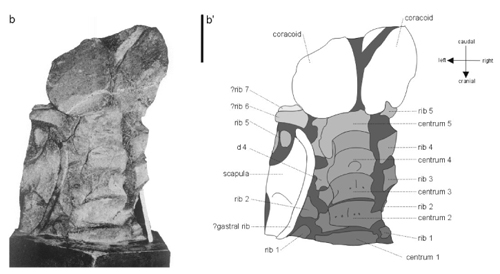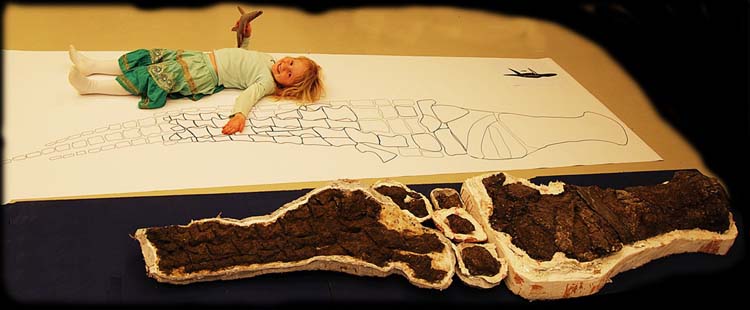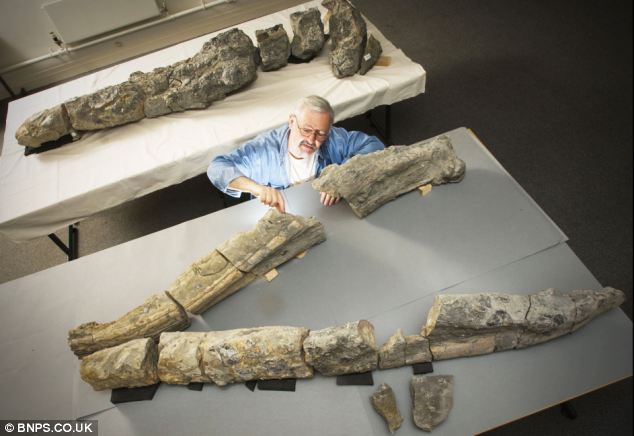Mine’s bigger than yours! The Monster of Aramberri, Predator X, and other monster pliosaurs in the media
During the past decade several dramatically named giant pliosaurs have hit the mainstream media, many claiming to be the biggest yet discovered. But only a trickle of peer-reviewed literature has been published to accompany these news stories. The lack of published data makes it really difficult to sift the facts from the fiction, and it’s easy to get the different stories muddled up, especially in the case of two identically sized congeneric pliosaur specimens from Svalbard: ‘The Monster’ and ‘Predator X’. So in an attempt to iron out the details and assess what we really know about all these specimens, here’s a short summary of the main players.
The Monster of Aramberri
Hit the mainstream media: 2002.
Estimated length in media: 18 m.
Conservative estimated length 15 m.
Material: Partial vertebral column, proximal end of a femur, part of the pelvic girdle, and cranial fragments. The fragment of rostrum collected in 1985 is now lost.
Where: Aramberri, Mexico.
Excavation: The original excavation in 1985 yielded a partial rostrum and vertebral column. The excavation site was reidentified in 2001 and additional material was collected during 2001 and 2002.
Peer-reviewed scientific references: Buchy et al. (2003).
Notes: The material was collected over a period of several years, but the discovery only hit the mainstream media in 2002 when more substantial pieces of the skeleton were discovered. An excellent account of the ‘Monster of Aramberri’ is given here by Richard Forrest. Buchy et al. (2003) described UANL-FCT-R2, the partial vertebral column discovered in 1985 [pictured below], but the majority of the skeleton has not been described and is in the process of being prepared. I’ve confirmed with Marie-Celine that the vertebrae described in 2003 are part of the ‘Monster of Aramberri’, but it is worth noting that the 2003 paper doesn’t explicitly mention ‘The Monster of Aramberri’ by name. Originally referred to Liopleurodon, it isn’t considered so any more (Buchy and Frey 2003).

The Monster
Hit the mainstream media: October 2006
Estimated length in media: 15 metres
Conservative estimated length: 13-15 m
Material: anterior part of rostrum, two cervical and numerous dorsal vertebrae, a nearly complete coracoid and right forelimb, and several dorsal ribs and gastralia.
Where: Svalbard, Norway.
Excavation: Discovered in 2006 and excavated in 2007.
Peer-reviewed scientific literature: none.
Notes: ‘The Monster’, not to be confused with ‘The Monster of Aramberri’, was the first pliosaur from Svalbard to be excavated and the first to make the news. A second giant pliosaur (‘Predator X’, see below) was discovered at the same time, but was excavated the following season. Richard Forrest’s 2008 article on the plesiosaurs from svalbard provides a thorough discussion, including comments on ‘The Monster’, but it was written before the second pliosaur hit the mainstream media.

Predator X
Hit the mainstream media: March 2009
Estimated length in media: 15 m
Conservative estimated length: 13-15 m
Material: Partial skeleton including posterior skull region and anterior cervical vertebrae.
Where: Svalbard, Norway.
Excavation: Discovered in 2006 and excavated in 2008.
Peer-reviewed scientific literature: none.
Notes. The fossil material attributed to this pliosaur was first mentioned in stories covering “The Monster” in 2008, but the name ‘Predator X’ was coined after the specimen was excavated and it hit the media in 2009. According to an SVP poster by Knutsen et al. (2009) both ‘The Monster’ and ‘Predator X’ belong to the same taxon – they are congeneric and they are closest in their anatomy to Pliosaurus. They are both estimated to be the same size, and they are also both from the same geological formation, so with all these similarities it’s easy to confuse the two. ‘Predator X’ inspired the cover story for the 31 October 2009 issue of New Scientist, and was the main subject of a recent History Channel documentary of the same name, which also featured another giant pliosaur – the Weymouth Bay pliosaur. ‘Predator X’ will also appear in the BBC’s upcoming series Planet Dinosaur. Despite its widespread presence in the news and on TV, I was unable to find a suiatable photograph of the actual material.
The Weymouth Bay pliosaur
Hit the mainstream media: October 2009
Estimated length in the media: 16 m
Conservative estimated length: 12 m.
Material: skull and mandible (missing the tip of the manibular symphysis).
Where: Weymouth Bay, Dorset, UK.
Excavation: Discovered in pieces over a period of time – specific details unclear. The specimen was purchased by Dorset County Museum in Dorchester.
Peer-reviewed scientific literature: none.
Notes: There is an excellent account of the Weymouth Bay pliosaur here by Richard Forrest. The skull as preserved is 2.1m long.

So there we have it, four mega-pliosaurs making big news in the space of a decade. All of them have conservative and realistic length estimates around the 15m mark, with the Weymouth Bay pliosaur possibly slightly smaller and ‘The Monster of Aramberri’ possibly slightly larger. But all the estimates are way too wooly to take seriously just yet. So all these monsters will remain jostling for top spot until the scientific papers are published, and until we have a better understanding of pliosaurid proportions.
There are or course plenty of other giant pliosaurs, which frequently pop up in discussions too, including additional real contenders for ‘biggest pliosaur ever!’. While I do plan to write more on giant pliosaurs in the future, I’ve stuck to the ones in the mainstream media for now. You might have noticed that Liopleurodon was conspicuously omitted from this post. Well, although it is entirely relevant to the present topic, it hasn’t been in the news recently so I decided to leave the magical Liopleurodon alone this time around. It will be nice to write about a pliosaur with an actual scientific name for a change, even if that’s opening a can of worms in itself!
References
Buchy, M.-C. & Frey, E. 2003. Was it really eating granite? We’re searching hard: history of the Monster
of Aramberri (and stories about it). First meeting of the EAVP – abstracts, 39.
Buchy M.-C., Frey E., Stinnesbeck, W. ; López-Oliva J.G. 2003. First occurrence of a gigantic pliosaurid plesiosaur in the Late Jurassic (Kimmeridgian) of Mexico. Bulletin de Societe géologique de France, 174, 271-278.
Knutsen, E., Druckenmiller, P., Hurum, J., Nakrem, H. 2009. Preliminary account of new Late Jurassic pliosaurid material from Svalbard, Norway. Journal of Vertebrate Paleontology, 128A.
Noè, L. F., Smith, D. T. J. & Walton, D. I. 2004. A new species of Kimmeridgian pliosaur (Reptilia; Sauropterygia) and its bearing on the nomenclature of Liopleurodon macromerus. Proceedings of the Geologists’ Association 115, 13-24.

Didnt Knutsen et al (2009) wrote that “The monster” and “Predator X” are conSPECIFIC?
They certainly did. I’m not sure why I wrote ‘congeneric’, although by definition that’s technically correct too!
Ah, thanks 🙂
You wrote “Conservative estimated lenght: 15 m” because of Buchy (2007) having written that the indeterminate pliosaurid from La Caja Formation isnt necessarily a juvenile? If she was right, it would be more reasonably within the already known sizes of giant pliosauroids, i guess
Heres the link
digbib.ubka.uni-karlsruhe.de/volltexte/documents/21575
And what about OUM J.10454, the 3 mandible referred to Stretosaurus macromerus, the “new” 3 m mandible found in Kimmeridge Bay (Noé, Smith & Walton, 2004) and new holotypic remains of Megalneusaurus rex (Wahl, Massare & Ross, 2010)?
PS
Great blog!
In this post I’m dealing only with the giant pliosaurs in the mass media. But I’m also formulating another post on the other less infamous pliosaurs you mentioned…
I took the 15m estimate for the Monster of Aramberri from Buchy et al. (2003). Thanks for the link to Buchy (2007) though.
Ok… ill wait for your post
And thanks for the pdfs! 🙂
Dr Buchy confirmed me that Aramberri wasn’t properly a juvenile in the same way as the mammals and was more 15 m long than 18 m.
Seems that some things have developed since this blog post has been written. First the Svalbard specimen have been published and current estimates put them in the 10-13m range.
Further the vertebral dimensions of the monster of Aramberri can be found in Buchy et al. 2003.
Comparison of the vertebral elements of the large pliosaurs in the supplementary material of Knutsen et al. 2012 description of P.funkei lead me to suspect that it too did not scratch the 15m mark. Seems like the cumnor mandible is the largest pliosaurian remain for now.
References:
Knutsen, E.M., Druckenmiller, P.S. & Hurum, J.H. (2012). “A new species of Pliosaurus (Sauropterygia: Plesiosauria) from the Middle Volgian of central Spitsbergen”
Buchy, M.C., Frey, E., Stinnesbeck, W., Lopez-Oliva, J.G., (2003). “First occurrence of a gigantic pliosaurid plesiosaur in the late Jurassic (Kimmeridgian) of Mexico”
[…] useful adaptation to an aquatic lifestyle. I’ve written before about the fossil evidence for huge pliosaurs, and the maximum size estimates level off at around 15m. Hawthorn’s speculative 24m long […]
[…] bodies up to 15 metres long, and a set of teeth that would make a crocodile blush. A few of the larger discoveries have inspired names such as “Predator X” from Norway, and “The Monster of Aramberri” in […]